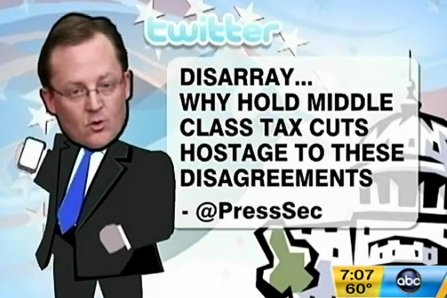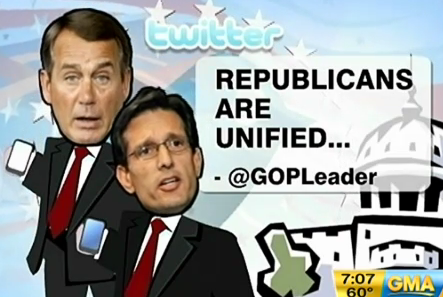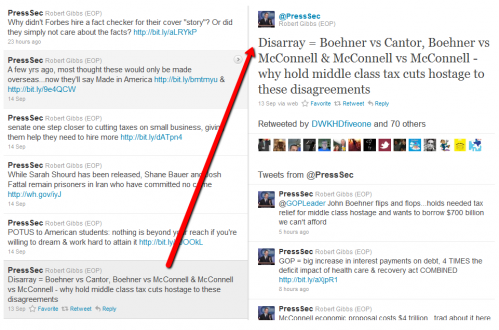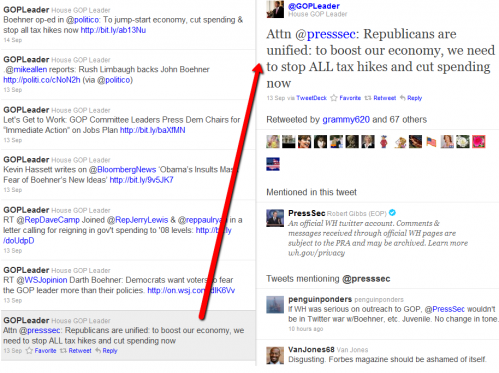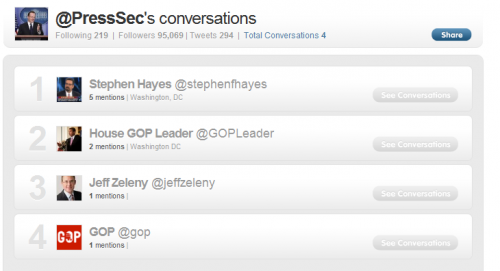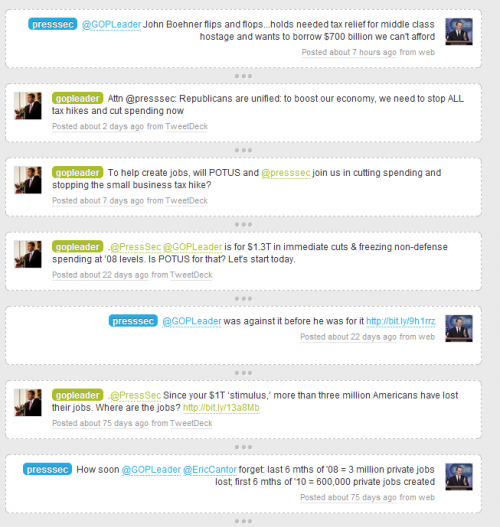Watching The Democrats & Republicans Go At It, Twitter-Style
On the Daily Show earlier this week, Jon Stewart did a funny takedown of the White House and the Republicans having a back-and-forth on Twitter. But while the conversation was real, hunting it down to see it yourself an ordinary Twitter user is pretty tough. Replies Vs. Mentions The problem is due what I call […]
On the Daily Show earlier this week, Jon Stewart did a funny takedown of the White House and the Republicans having a back-and-forth on Twitter. But while the conversation was real, hunting it down to see it yourself an ordinary Twitter user is pretty tough.
Replies Vs. Mentions
The problem is due what I call “manual replies,” something I wrote about yesterday in our The New Twitter & Search, An Illustrated Guide story. These are replies when someone is called out by name in a tweet, rather than being answered by using the actual reply button in Twitter or a Twitter application.
Do that, and you’ve done a manual reply — or what Twitter calls a “mention” — something that makes it hard to see a conversation unfold. Twitter explains more about this here.
To confuse things even more, Twitter also considers something to be a reply if you start a message with someone’s user name. However, I’ve found that this doesn’t always translate into a trackable-reply, for rebuilding a conversation.
Political Conversations, Twitter-Style
The Daily Show segment about the White House-Republican conversation on Twitter is at the end of this post for your enjoyment. It’s pretty funny.
It kicks off with Stewart showing a segment from ABC’s Good Morning America, which covers White House press secretary Robert Gibbs tweeting about the Republicans being in “disarray” on middle class tax issues:
In response, House Republican leader John A. Boehner tweeted back that the the GOP was indeed unified, something that other Republicans retweeted:
The exchange left Stewart to comment:
Once again our national discourse over one of the most complicated and important issues devolves into Twittersnaps.
Or maybe it’s two words: Twitter Snaps. Stewart didn’t specify! But he went on to joke about further exchanges involving farting Cheetos dust and the E-Trade baby:
Fun stuff. But in seriousness, what if you wanted to see the actual exchange? Bad news. You can’t do it on Twitter.
Where’s The Conversation?
Here’s the actual tweet from Gibbs that started it all:
The screenshot above shows how in Twitter’s new look, you can click on the tweet and get more information about it. You’re told that, at the time I looked at this, 70 people had retweeted this (though only 15 are shown).
What’s missing are replies to the tweet. If there were any, they should appear right below the retweet line. Boehner’s isn’t there. So did Boehner really reply?
Yes, he did — he just didn’t use the reply button or begin his tweet by using the @presssec account name, which would register as a reply to that account. Here’s his tweet:
See how the tweet begins:
Attn @presssec: Republicans are unified
Calling out the White House’s official press secretary account by name might seem a reply to a human being. But in Twitter’s automated world, that’s a mention, not a reply.
A mention means the person mentioned can see the message easily. For example, Gibbs could discover Boehner’s response by browsing the “mentions” feature that Twitter and many Twitter applications provide. However, that’s not a “conversation” that’s easily tracked by the typical Twitter user.
Also note that while many Republican leaders were said to have retweeted this, it’s hard to spot them on the page about the tweet. It’s not that they didn’t retweet it. It’s simply that Twitter is showing only 15 retweets in all, just as it did with the White House tweet.
Finding Conversations
I’ll get back to Democrat and Republican discourse in a moment, but first, more about actual conversations that happen on Twitter and how to view them.
In Twitter’s new design, you do get some conversation support, but you’ll only see one part of an overall conversation. For example, consider this exchange between two people that I found using Twitter Search:
You can see the two people going back and forth with each other. It’s a real conversation, and showing an entire conversation is something that Twitter Search support. But most people don’t use Twitter Search, which is Twitter’s standalone search engine. Instead, they interact with Twitter through the main Twitter.com web site.
There, if I go to any particular tweet in the full conversation above, Twitter’s new look will show only the most immediate exchange:
As for exchanges like I’ve covered between Gibbs and Boehner, forget it. Since they weren’t technically replies, Twitter doesn’t link them together.
Neither does Google, which debuted its own conversation tool recently as part of Google Realtime search (see Google Realtime Search Gets Home Page, Conversation View, Alerts & Geosearch for more).
Reunited, It Would Feel So Good
Is there any tool that can unite both parties in a conversation, even if they aren’t having one technically? Sort of.
Beetween is a tool I found when poking around. Several people also recommended it when I asked for advice on conversation tracking tools on Twitter. Just enter the name of a Twitter user (or two users), and it comes back with matching conversations.
I checked to see who Gibbs seemed to be talking to via the @presssec account:
Four total conversations, which seemed a bit low. But there was Boehner’s @gopleader account listed, along with other conversations, which was pretty neat. I selected the ones related to the @gopleader account.
While the GOP reply mentioned on the Daily Show is in this conversation list, the tweet that actually sparked that reply from the White House wasn’t actually there.
TweetConvo was another tool suggested. Unlike Beetween, you can’t submit a Twitter account name and see possible conversations. Instead, you enter the URL of a tweet to see any responses to it. I fed it the original White House tweet, but it couldn’t discover the GOP reply. Nor from the GOP reply could it discover the White House URL.
Some people suggested tools like HootSuite or TweetDeck. HootSuite does have a conversation view option, but that’s only for people you might be replying to or getting replies from, as best I can tell. It doesn’t help with third-party conversations. As for TweetDeck, it apparently only shows conversation views for conversations that are official replies.
The Importance Of Replying In Earnest
Back to replies. Another issue with them is that true “technical” replies are only seen by other people if they are following both parties in a conversation.
For example, if @gopleader were to do an official reply to @presssec — using the reply button and.or putting @presssec at the start of the tweet — that reply would NOT been seen by people following @gopleader unless those people were also following @presssec.
As you can imagine, there will be plenty of people who support one party that will not follow the leadership of another. That’s one reason why official replies might not be used. If a Democrat yells at a Republican, they want all their Democrat followers to know that. Same is true for the Republicans. Doing technical replies prevents this. But by doing a mention, everyone sees who you are yelling at.
That’s one reason why you’ll see account names showing up further within the text of a tweet, or sometimes if they’re at the beginning of a tweet being preceded by the . symbol or some other character, like in these examples from both @gopleader and @presssec
.@mikeallen reports: Rush Limbaugh backs John Boehner https://politi.co/cNoN2h (via @politico)
the facts @stephenfhayes there would be ZERO capital gains on small business investment, expand tax cuts for new equip investments
Doing this ensures that a tweet is seen as a mention, not as a reply — and so all your followers will see what you said. But doing this also destroys the ability to easily reconstruct a conversation.
In the end, it seems as if as in real life, the Democrats and Republicans are talking at each other on Twitter, rather than talking to each other. At least in this case, they have some Twitter technicalities to blame. Still, I’d love to see more real conversation and listening.
Now go enjoy John Stewart. He gets into the Twitter bit around 6:30 in:
| The Daily Show With Jon Stewart | Mon – Thurs 11p / 10c | |||
| Faces of Debt | ||||
|
||||
Opinions expressed in this article are those of the guest author and not necessarily Search Engine Land. Staff authors are listed here.
Related stories
